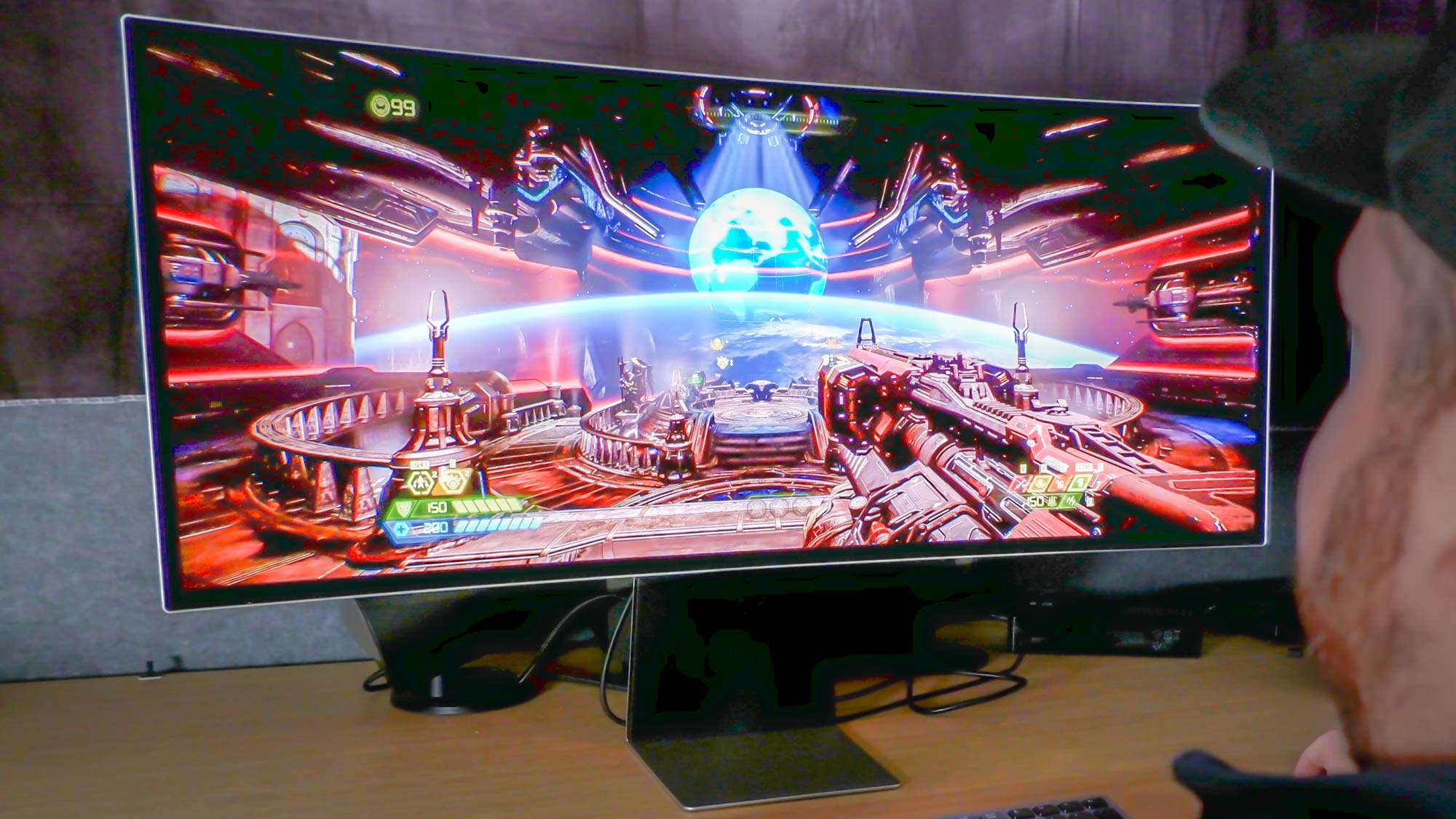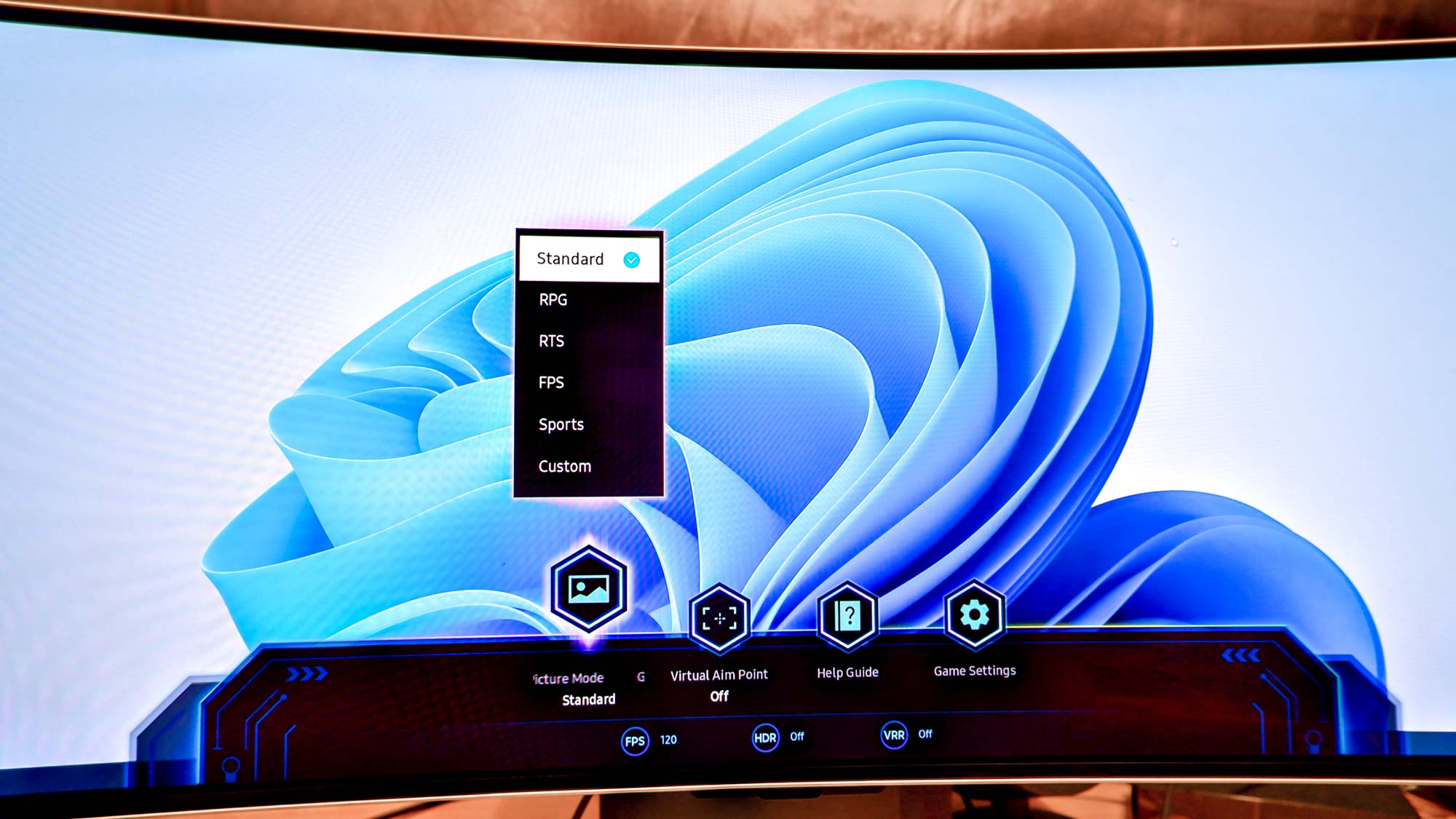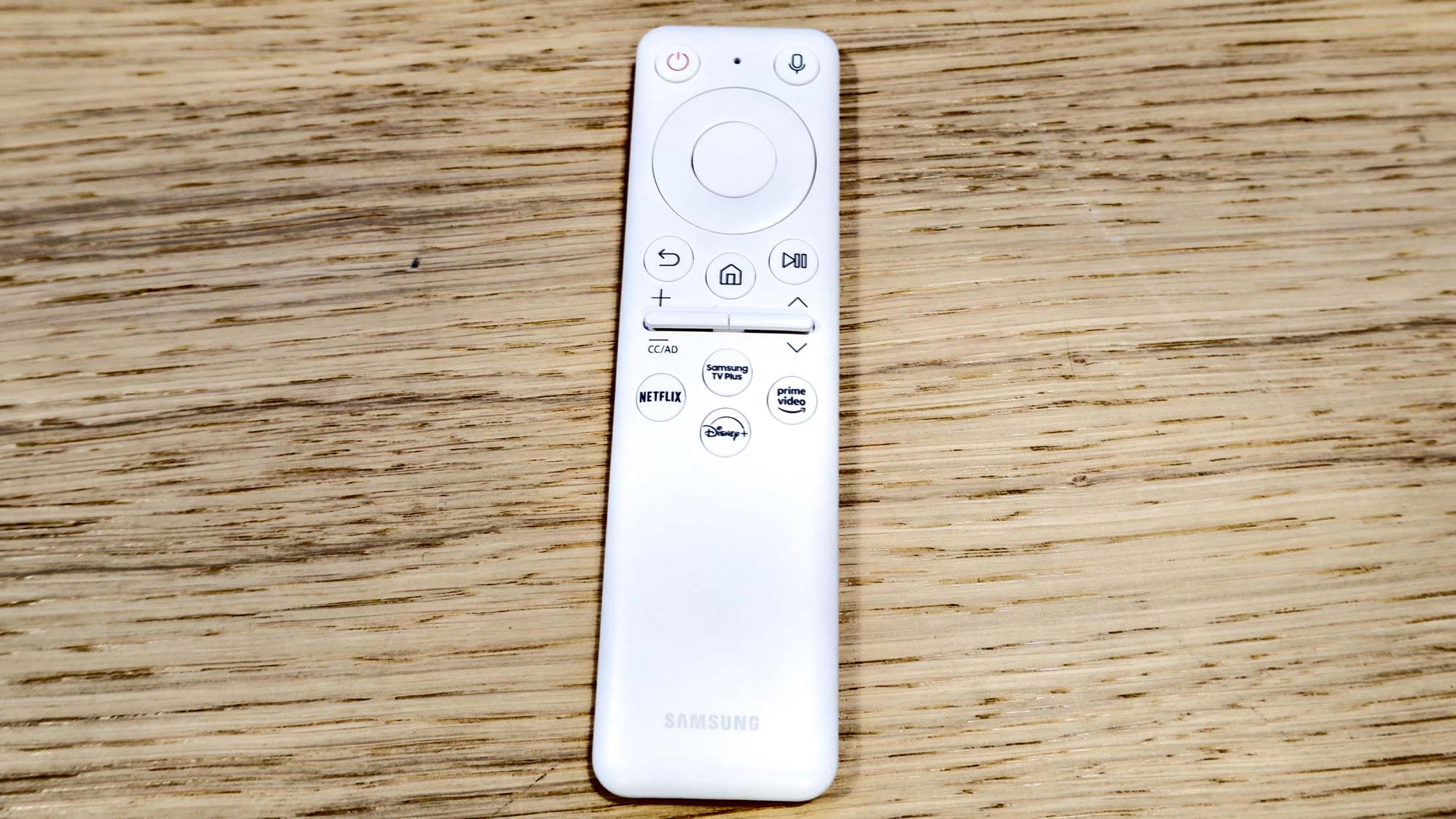Tom's Guide Verdict
The Samsung Odyssey OLED G8 gaming monitor has a lot going for it, including an immersive 34-inch curved display, zippy performance and a sleek, elegant design. Though pricey, it excels at delivering an enjoyable gaming experience.
Pros
- +
Immersive 34-inch curved display
- +
Vivid, sharp picture quality
- +
Elegant design
Cons
- -
Pricier than competition
- -
Poor speaker quality
Why you can trust Tom's Guide
The Samsung Odyssey OLED G8 ($1,499) is a stylish OLED curved gaming monitor that’s a serious rival for the Alienware AW3423DWF. Like that monitor, the Odyssey OLED G8 features an immersive 34-inch curved display with stunning picture quality. Its fast 175Hz refresh rate and low 0.03ms response time deliver solid performance, especially for games that require quick reflexes. Add Samsung’s smart TV and gaming hub apps, and you have one of the best curved monitors and best gaming monitors we’ve reviewed.
While pricey, the Samsung Odyssey OLED G8 is an overall brilliant gaming monitor. In fact, it’s now become my favorite monitor of 2023 so far. In my review, I’ll detail what makes the Odyssey OLED G8 and why you should seriously consider buying it.
Samsung Odyssey OLED G8 review: Specs
| Header Cell - Column 0 | Samsung Odyssey OLED G8 |
|---|---|
| Price | $1,499 |
| Dimensions | 32.3 x 18.0 x 7.3 inches |
| Screen size | 34 inches |
| Resolution | 3,440 x 1,440 |
| Refresh rate | 175Hz |
| Inputs | 1x Mini DP 2, 1x Micro HDMI, 2x USB-C |
| Response time | 0.03ms |
| Aspect ratio | 21:9 |
| Panel type | OLED |
| Weight | 16.5 pounds (with stand) |
Samsung Odyssey OLED G8 review: Price and availability
- Priced at $1,499
The Samsung Odyssey OLED G8 is now available from the Samsung store for $1,499. This is the only available configuration.
Samsung Odyssey OLED G8 review: Design
- Stylish design
- Minimal port selection
The Odyssey OLED G8 is one of the most striking gaming monitors I’ve reviewed. Its all-silver plastic chassis gives the monitor a futuristic tinge, as does the RGB lighting surrounding the monitor mount on the back. Besides those flourishes, the monitor has an overall minimalist appearance I find appealing.

The wide L-shaped stand doesn’t take up much space on a desk, and since its base is flat, you’re free to keep items on it. I would have preferred if the stand had a built-in Qi charger like the HP Envy 34 All-in-One, but that’s a minor gripe on my end.
Raising and lowering the monitor to my preferred height presented no problems. Since the stand has an opening you can put cables through, said cables won’t get in the way when you’re adjusting the monitor’s position. And of course, keeping all the cables tucked through the stand’s opening eliminates desk clutter.

There are a minimal number of ports located on the monitor’s lower back. This includes a single Mini DP 2 port, a Micro HDMI port and two USB-C ports. Unfortunately, standard DisplayPort and HDMI cables aren’t compatible with the Odyssey OLED G8 — which is a bummer if you wanted to use cables you already have lying around. There’s also an OSD (on-screen display) joystick to bring up and move through the main menu.
Get instant access to breaking news, the hottest reviews, great deals and helpful tips.
Samsung Odyssey OLED G8 review: Display
- Immersive curved display
- Vivid picture quality
The Odyssey OLED G8 has a 34-inch 3,440 x 1,440 OLED curved display that’s tailor-made for some of the best PC games. The 1,800R curvature immerses you in whatever you’re playing, while the overall vibrant display makes everything look phenomenal.

Games utilizing a first-person perspective truly take advantage of the monitor’s curved display. When I fired up Doom Eternal and Cyberpunk 2077, I felt like I was dropped into the middle of their respective worlds. Details like alien ruins in the former and neon-drenched streets in the latter came through nicely, and I often stopped to take in the surroundings. I can’t do justice to how gorgeous games look on this monitor.
There are a grand total of ten display modes. Five are dedicated game modes, while the rest are suited for watching videos, movies and TV shows. The five game modes in question include Standard, RPG, FPS, RTS and Sports.
Each display mode is slightly different and optimized for the game types they’re named after. This is all standard fare for gaming monitors and it’s good to have so many presets to choose from. That said, I mostly stuck with Standard mode since it delivered a nice balance of brightness and color accuracy compared to the other modes.
| Header Cell - Column 0 | Samsung Odyssey OLED G8 | Alienware AW3423DWF | Acer Predator X32 FP |
|---|---|---|---|
| Nits (brightness) | 240 | 236 | 404 |
| sRGB | 183.3% | 180% | 226% |
| DCI-P3 | 129.9% | 127% | 160% |
| Delta-E | 0.12 | 0.24 | 0.26 |
How did the display do in our lab tests? When we pointed our Klein-10A colorimeter at it, we found that the Odyssey OLED G8’s screen achieved an average brightness of 240 nits of brightness in Standard mode. That’s on par with the Alienware AW3423DWF (236 nits) but much dimmer than the Acer Predator X32 FP (404 nits) in their respective standard modes. That said, the Odyssey OLED G8 achieved 357 nits of HDR brightness across 10 percent of the display in our testing, which is fairly bright.
Most of the display’s modes produce oversaturated colors, which I personally quite liked. Doom Eternal and Cyberpunk 2077 benefit greatly since both have colorful worlds. In Standard mode, the display covered 183.3% of the sRGB color gamut and 129.9% of the more demanding DCI-P3 color space (closer to 100% is best), with a Delta-E value of 0.12 (closer to 0 is ideal). We saw these values across most of the available display modes.
How does that compare to other gaming monitors? In its Standard mode, the AW3423DWF covered 180% of the sRGB color gamut and 127% of the DCI-P3 gamut, with a Delta-E value of 0.24. The Predator X32 FP’s display achieved 226% of the sRGB color gamut and 160% of the DCI-P3 color gamut, with a Delta-E value of 0.26. In short, the Odyssey OLED G8’s brightness and color accuracy aren’t far off from the competition.
Samsung Odyssey OLED G8 review: Performance
- Smooth 175Hz refresh rate
- Fast response time
Games run buttery-smooth on the Odyssey OLED G8 thanks to its 175Hz refresh rate and 0.03ms response time. I had a blast (no pun intended) playing Doom Eternal because of how effortless it felt to run around the environments shooting anything that got in my way. I never felt an ounce of input lag, which is great since Doom Eternal demands you constantly stay on the move.

Support for features like Adaptive Sync and AMD FreeSync Premium Pro also helps games run their best on this display. I never once saw screen tearing or choppiness, even during intense combat encounters in Doom Eternal and Cyberpunk 2077.
I connected the monitor to the Dell XPS 8950, which has a 12th gen Intel Core i5-12600k processor, an Nvidia GeForce RTX 3060 Ti GPU and 16GB of RAM. Thanks to that system’s specs, I was able to run Doom Eternal at around 160 frames per second at high settings. The Odyssey OLED G8’s 175Hz has no problem handling such high framerates. And while the monitor isn’t G-Sync certified, its VRR tech ensures a smooth gaming experience for those with Nvidia GPUs.
Samsung Odyssey OLED G8 review: Audio
- Loud built-in speakers
- Thin overall sound quality
The Odyssey OLED G8’s built-in speakers are decent enough, but I wouldn’t want to use them as my primary speakers when using this monitor.
While the speakers can get fairly loud without distortion, everything sounds too thin and tinny — which can become grating over time. You’re better off using one of the best wireless headphones instead.
Samsung Odyssey OLED G8 review: Interface and features
- Intuitive menu
- Packs Samsung’s smart TV and gaming hubs
You can bring up the Odyssey OLED G8’s menu with either the OSD joystick or the included remote control. The interface features a semi-transparent blue background with bold white lettering. The joystick used for sorting through the menu’s options is responsive, making it simple to access whichever option you’re looking for.

Switching to game mode lets you access the game-specific display options mentioned above. If you want, you can adjust any of these modes’ attributes like brightness, contrast and such. HDR is automatically enabled for games that support the feature.
Like some of the recent best Samsung TVs, the Odyssey OLED G8 features the company’s smart TV and game hubs — which both utilize Samsung’s Tizen platform. The former has all the major streaming apps and a bunch of free content from Samsung TV Plus.

The game hub has streaming apps like Xbox Game Pass, Nvidia GeForce Now and Amazon Luna. If you don’t own a gaming console or a gaming PC, you’re still able to play games on this TV right out of the box. All you have to do is pair your favorite gaming controller to the monitor and fire up a game-streaming app. You can even use a game controller to navigate through the game hub, which is a nice touch.
Samsung Odyssey OLED G8 review: Verdict
At $1,499, the Samsung Odyssey OLED G8 isn’t cheap. Though it doesn’t get too bright, the G8 makes up for that with its immersive curved display which delivers sharp and vibrant images. Its performance is top-notch and capable of handling the most demanding fast-paced shooters. And if you don’t own a gaming console or PC, you can fire up any of the cloud gaming services in the Samsung gaming hub.
If the Odyssey OLED G8 is too expensive, the $999 Alienware AW3423DWF is a rock-solid alternative that offers a similar experience. If you don’t like curved displays, the $1,299 Acer Predator X32 FP is another awesome and more affordable option.
Price-aside, the Samsung Odyssey OLED G8 is an all-around winner. If you can afford it, it’s worth checking out.

Tony is a computing writer at Tom’s Guide covering laptops, tablets, Windows, and iOS. During his off-hours, Tony enjoys reading comic books, playing video games, reading speculative fiction novels, and spending too much time on X/Twitter. His non-nerdy pursuits involve attending Hard Rock/Heavy Metal concerts and going to NYC bars with friends and colleagues. His work has appeared in publications such as Laptop Mag, PC Mag, and various independent gaming sites.

